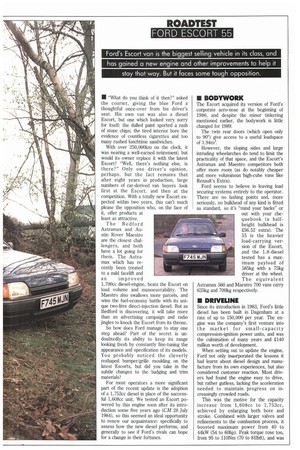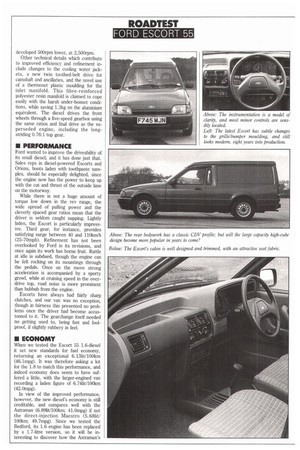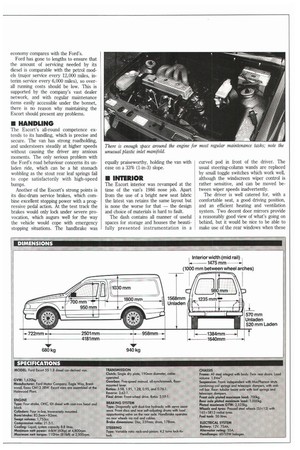ROADTEST FORD ESCORT 55
Page 61

Page 62

Page 63

Page 64

If you've noticed an error in this article please click here to report it so we can fix it.
Ford's Escort van is the biggest selling vehicle in its class, and has gained a new engine and other improvements to help it stay that way. But it faces some tough opposition.
• "What do you think of it then?" asked the courier, giving the blue Ford a thoughtful once-over from his driver's seat. His own van was also a diesel Escort, but one which looked very sorry for itself: the dulled paint sported a rash of stone chips; the tired interior bore the evidence of countless cigarettes and too many rushed lunchtime sandwiches.
With over 250,000km on the clock, it was nearing a well-earned retirement; but would its owner replace it with the latest Escort? "Well, there's nothing else, is there?" Only one driver's opinion, perhaps, but the fact remains that after eight years in production, large numbers of car-derived van buyers look first at the Escort, and then at the competition. With a totally new Escort expected within two years, this can't much please the opposition who, on the face of it, offer products at least as attractive.
The Bedford Astramax and Austin Rover Maestro are the closest challengers, and both have a lot going for them. The Astramax which has recently been treated to a mild facelift and
an improved 1,700cc diesel-engine, beats the Escort on load volume and manoeuvrability. The Maestro also swallows more parcels, and wins the fuel-economy battle with its unique two-litre direct-injection diesel. But as Bedford is discovering, it will take more than an advertising campaign and radio jingles to knock the Escort from its throne.
So how does Ford manage to stay one step ahead? Part of the secret is undoubtedly its ability to keep its range looking fresh by constantly fine-tuning the appearance and specification of its models. You probably noticed the cleverly reshaped bumper/grille moulding on the latest Escorts, but did you take in the subtle changes to the badging and trim materials?
For most operators a more significant part of the recent update is the adoption of a 1,753cc diesel in place of the successful 1,608cc unit. We tested an Escort powered by this engine soon after its introduction some five years ago (CM 28 July 1984), so this seemed an ideal opportunity to renew our acquaintance: specifically to assess how the new diesel performs, and generally to see if Ford's rivals can hope for a change in their fortunes.
NMI
• BODYWORK
The Escort acquired its version of Ford's corporate aero-nose at the beginning of 1986, and despite the minor tinkering mentioned earlier, the bodywork is little changed for 1989.
The twin rear doors (which open only to 900) give access to a useful loadspace of 1.94m3.
However, the sloping sides and large intruding wheelarches do tend to limit the practicality of that space, and the Escort's Astramax and Maestro competitors both offer more room (as do notably cheaper and more voluminous high-cube vans like Renault's Extra).
Ford seems to believe in leaving load securing systems entirely to the operator. There are no lashing points and, more seriously, no bulkhead of any kind is fitted as standard, so it's "mind your backs" or out with your chequebook (a halfheight bulkhead is 256.52 extra). The 55 is the heavier load-carrying version of the Escort, and the 1.8-diesel tested has a maximum payload of 585kg with a 75kg driver at the wheel. The equivalent Astramax 560 and Maestro 700 vans carry 635kg and 700kg respectively.
• DRIVELINE
Since its introduction in 1983, Ford's little diesel has been built in Dagenham at a rate of up to 150,000 per year. The engine was the company's first venture into the market for small-capacity compression-ignition power units, and was the culmination of many years and £140 million worth of development.
When setting out to update the engine, Ford not only inGorporated the lessons it had learnt about diesel design and manufacture from its own experiences, but also considered customer reaction. Most drivers had found the engine easy to drive, but rather gutless, lacking the acceleration needed to maintain progress on increasingly crowded roads.
This was the motive for the capacity increase from 1,608cc to 1,753cc, achieved by enlarging both bore and stroke. Combined with larger valves and refinements to the combustion process, it boosted maximum power from 40 to 44kW (54 to 60hp). Peak torque rose too, from 95 to 110Nm (70 to 811bft), and was developed 500rpm lower, at 2,500rpm.
Other technical details which contribute to improved efficiency and refinement include changes to the cooling water jackets, a new twin toothed-belt drive for camshaft and ancillaries, and the novel use of a thermoset plastic moulding for the inlet manifold. This fibre-reinforced polyester resin manifold is claimed to cope easily with the harsh under-bonnet conditions, while saving 1.3kg on the aluminium equivalent. The diesel drives the front wheels through a five-speed gearbox using the same ratios and final drive as the superseded engine, including the longstriding 0.76:1 top gear.
• PERFORMANCE
Ford wanted to improve the driveability of its small diesel, and it has done just that. Sales reps in diesel-powered Escorts and Orions, boots laden with toothpaste samples, should be especially delighted, since the engine now has the power to keep up with the cut and thrust of the outside lane on the motorway.
While there is not a huge amount of torque low down in the rev range, the wide spread of pulling power and the cleverly spaced gear ratios mean that the driver is seldom caught napping. Lightly laden, the Escort is particularly impressive. Third gear, for instance, provides satisfying surge between 40 and 110km/h (25-70mph). Refinement has not been overlooked by Ford in its revisions, and once again its work has borne fruit. Rattle at idle is subdued, though the engine can be felt rocking on its mountings through the pedals. Once on the move strong acceleration is accompanied by a sporty growl, while at cruising speed in the overdrive top, road noise is more prominent than hubbub from the engine.
Escorts have always had fairly sharp clutches, and our van was no exception, though in fairness this presented no problems once the driver had become accustomed to it. The gearchange itself needed no getting used to, being fast and foolproof, if slightly rubbery in feel.
• ECONOMY
When we tested the Escort 55 1.6-diesel it set new standards for fuel economy, returning an exceptional 6.131it/100km (46.1mpg). It was therefore asking a lot for the 1.8 to match this performance, and indeed economy does seem to have suffered a little, with the larger-engined van recording a laden figure of 6.741it/100km (42.0mpg).
In view of the improved performance, however, the new diesel's economy is still creditable, and compares well with the Astramax (6.891it/100km; 41.0mpg) if not the direct-injection Maestro (5.681it/ 100km; 49.7mpg). Since we tested the Bedford, its 1.6 engine has been replaced by a 1.7-litre version, so it will be interesting to discover how the Astramax's
economy compares with the Ford's.
Ford has gone to lengths to ensure that the amount of servicing needed by its diesel is comparable with the petrol models (major service every 12,000 miles, interim service every 6,000 miles), so overall running costs should be low. This is supported by the company's vast dealer network, and with regular maintenance items easily accessible under the bonnet, there is no reason why maintaining the Escort should present any problems.
II HANDLING
The Escort's all-round competence extends to its handling, which is precise and secure. The van has strong roadholding, and understeers steadily at higher speeds without causing the driver any anxious moments. The only serious problem with the Ford's road behaviour concerns its unladen ride, which can be a bit stomach wobbling as the stout rear leaf springs fail to cope satisfactorily with high-speed bumps.
Another of the Escort's strong points is its disc-drum service brakes, which combine excellent stopping power with a progressive pedal action. At the test track the brakes would only lock under severe provocation, which augurs well for the way the vehicle would cope with emergency stopping situations. The handbrake was equally praiseworthy, holding the van with ease on a 33% (1-in-3) slope.
• INTERIOR
The Escort interior was revamped at the time of the van's 1986 nose job. Apart from the use of a bright new seat fabric the latest van retains the same layout but is none the worse for that — the design and choice of materials is hard to fault.
The dash contains all manner of useful spaces for storage and houses the beautifully presented instrumentation in a curved pod in front of the driver. The usual steering-column wands are replaced by small toggle switches which work well, although the windscreen wiper control is rather sensitive, and can be moved between wiper speeds inadvertently.
The driver is well catered for, with a comfortable seat, a good driving position, and an efficient heating and ventilation system. Two decent door mirrors provide a reasonably good view of what's going on behind, but it would be nice to be able to make use of the rear windows when these
are not obstructed by a load. Unfortunately this is often impossible due to the lack of rear wiper and rear window heating.
• SUMMARY
To exhume a headline from previous issues of Commercial Motor, the new 1.8 diesel Escort 55 really is "a van for all seasons". It goes to no extremes, but achieves all that it sets out to do.
The revamped diesel provides an excellent balance of performance and economy, and should serve Ford well. The bouncy unladen ride apart, road behaviour is sound, and the carefully developed interior provides a good environment.
Good though it is, the reason for the Escort's market dominance is not immediately apparent it is afterall, quantifiably inferior in certain areas, such as payload and load volume. Notoriously conservative fleet buyers are presumably swayed by Ford's dealer back-up, thoughtful pricing, strong residual values, and the simple fact that the van is a known quantity, a situation which is unlikely to change.
It may well be that the greatest threat to the sales of medium-sized vans like the Escort comes from the high-cube designs like the Renault Extra. These offer payload and load volume at least as good, but being based on the smaller super-mini class of cars, cost significantly less.
Ford has chosen not to follow this route with its new Fiesta van, so the chance still remains for a domestic manufacturer prepared to take up the challenge.
0 by Peter Watt




















































































































































